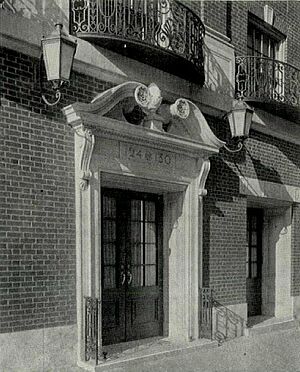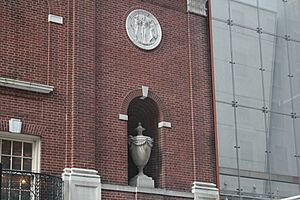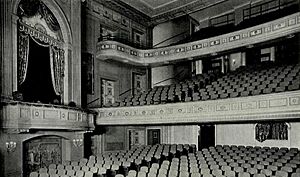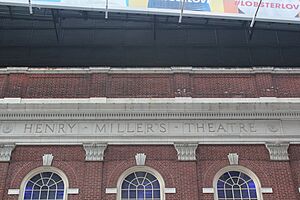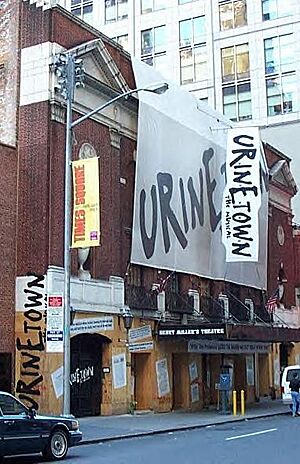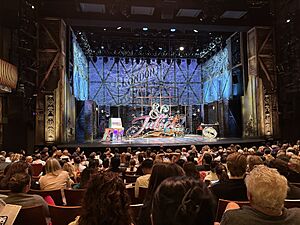Stephen Sondheim Theatre facts for kids
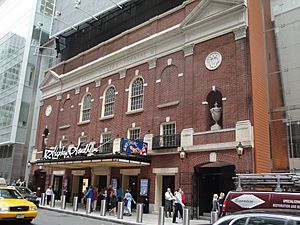
(2011)
|
|
| Address | 124 West 43rd Street Manhattan, New York United States |
|---|---|
| Coordinates | 40°45′21″N 73°59′06″W / 40.755869°N 73.985°W |
| Public transit | Subway: Times Square–42nd Street/Port Authority Bus Terminal or 42nd Street–Bryant Park/Fifth Avenue |
| Operator | Roundabout Theatre Company |
| Type | Broadway |
| Capacity | 1,055 |
| Production | & Juliet |
| Construction | |
| Opened | October 15, 2009 |
| Rebuilt | 2004-2009 |
| Years active | 1918-1968; 2001-2004; 2009-2010 (Henry Miller's Theatre) 1998 (as Kit Kat Club) 2010-present (Stephen Sondheim Theatre) |
| Designated | July 14, 1987 |
| Reference no. | 1357 |
| Designated entity | Facade |
The Stephen Sondheim Theatre is a famous Broadway theater in New York City. It is located at 124 West 43rd Street in the Theater District. This theater is owned by the Durst Organization and managed by the Roundabout Theatre Company.
The theater you see today opened in 2009. It has 1,055 seats and is mostly underground. It was designed by COOKFOX and Adamson Associates Architects. The theater kept the front part (facade) of the original Henry Miller's Theatre. That first theater was built in 1918 by Henry Miller, who was an actor and producer.
The original Henry Miller's Theatre had 950 seats. It was designed in a neoclassical style. Its facade is a protected city landmark. After Henry Miller passed away in 1926, his son Gilbert Miller took over. The Miller family sold the theater in 1966. The last musical there closed in 1969. For some years, it was used for different things, like a nightclub called Xenon from 1978 to 1984.
Henry Miller's Theatre became a Broadway theater again in 1998. The Roundabout Theatre Company put on a show called Cabaret there. For this show, the theater was called the Kit Kat Klub. After Cabaret moved to another theater, the musical Urinetown played there from 2001 to 2004.
After 2004, the inside of the old theater was taken down. A new, modern theater was built, still keeping the Henry Miller's name at first. It opened in 2009. In 2010, the theater was renamed the Stephen Sondheim Theatre. This was done to honor the famous American composer and lyricist Stephen Sondheim on his 80th birthday.
Contents
Exploring the Theater's Design
The Stephen Sondheim Theatre is at the bottom of the Bank of America Tower. It was first called Henry Miller's Theatre. The original design was by Paul R. Allen and Ingalls & Hoffman in 1918. The front of the building (facade) is from this original design. However, the inside of the theater was completely rebuilt in 2009.
The Theater's Front (Facade)
The facade is made of red brick and white marble. Henry Miller wanted it to look like an "American theatre." But it actually looks a lot like English theaters. It even has a style called neo-Georgian, which reminds people of English drama.
Unlike many theaters from its time, Henry Miller's Theatre had windows on its front. These windows let light into what used to be offices. The original facade is still there today. It now serves as the entrance to the new theater, which is mostly underground. This facade sticks out from the glass wall of the Bank of America Tower.
The bottom part of the facade has a granite base. Above that is the brick. There are five rectangular doorways in the middle. Each has metal doors. Above these doors are stone decorations with urns and flowers. When the theater was new, the middle three doors led to the ticket area. The other two doors led to different seating sections.
A large sign, called a marquee, hangs above the three center doorways. As of September 2010, this marquee shows the words "Stephen Sondheim." This reflects its new name.
Henry Miller's Theatre was the first Broadway theater built under a new rule from 1916. This rule changed how theaters were designed. The theater hid its side alleys behind the ends of the facade. The five center doorways are next to two arched gateways. These gateways have iron gates and lanterns.
The rest of the facade is red brick. It has two sections on the ends and five sections in the middle. Each section has brick columns called pilasters. These pilasters have fancy tops made of terracotta. The five middle sections have rectangular windows on the second floor. These windows have stone decorations and iron balconies.
On the third floor, there are three arched windows in the center. The end sections have arched brick spaces and round terracotta decorations. Above this is a terracotta band with "Henry Miller's Theatre" carved into it. There are also triangular shapes above the end sections. A low wall runs along the top of the facade. Above the theater's facade, there is a large billboard on the Bank of America Tower.
Inside the Theater: Then and Now
The inside of the original theater looked like old English rooms. The ticket lobby was oval-shaped. Its walls were cream-colored with purple-gray details. The floor was black and white marble.
The original auditorium had 950 seats. It was designed to feel cozy and "intimate." The main floor had 404 seats. The theater had two balcony levels. The higher one was called the "gallery." Henry Miller wanted two balconies because he remembered only being able to afford balcony seats when he was young. The gallery had 200 seats. The auditorium had gray walls and colorful decorations.
The front of the auditorium had a wooden area for the orchestra. Music came from openings above a screen. The stage was about 33 feet wide. It had an amber curtain. Above the curtain was a decoration with figures representing comedy and tragedy.
The 2009 Reconstruction
From 2004 to 2009, the old theater was replaced. The new 1,055-seat theater was designed by COOKFOX. It is about 50,000 square feet. Workers had to dig down 70 feet below the street. This is because the new theater could not be taller than the old facade. This makes it one of only two Broadway theaters that are mostly underground.
The entrance at street level leads to the mezzanine. The main seating area (orchestra level) is below that. The ground level has a bar and cafe. There is also an upper mezzanine with a restaurant. Two-thirds of the seats are on the orchestra level. The new theater still has some pieces from the original building. These include the old emergency exit doors and a plaster decoration from the auditorium.
The new theater was built to be very environmentally friendly. It uses recycled wall panels and local marble. It also has water-saving toilets. This makes the Stephen Sondheim Theatre the first Broadway theater to meet these "green building" standards. The design also made sure the theater is easy for everyone to use. For example, the women's restroom has 22 stalls, which is much more than required. The theater is also fully accessible for people with disabilities.
A Look at the Theater's History
The area around Times Square became a major spot for big theater shows between 1900 and the 1930s. Many theaters were built in Midtown Manhattan during this time, including Henry Miller's Theatre.
The Original Theater's Story
Henry Miller always dreamed of having his own theater. In 1916, he announced he would build one at 124-130 West 43rd Street. He leased the land from Elizabeth Milbank Anderson. Paul Allen and Ingalls & Hoffman were hired to design it.
Early Performances
Henry Miller's Theatre opened on April 1, 1918. The first play was The Fountain of Youth, starring Henry Miller himself. Critics liked the new theater, calling it "ideal" and "a delight." However, the first few plays were not very successful.
In July 1919, Klaw & Erlanger started managing the theater with Miller. Things improved with Mis' Nelly of N'Orleans in 1919, which ran for 127 shows. The musical La La Lucille was also a hit in May 1919.
Henry Miller starred in eight shows at his theater. Famous actors like Leslie Howard and Noël Coward made their Broadway debuts there. Other stars like Alfred Lunt, Billie Burke, and Helen Hayes also performed at the Henry Miller.
Gilbert Miller Takes Over
When Henry Miller died in 1926, his son Gilbert Miller became the manager. Gilbert bought out his father's business partner. The theater then became very successful from the 1930s to the 1950s.
In the 1930s, the theater hosted plays like The Good Fairy with Helen Hayes. Other popular shows included The Late Christopher Bean and Personal Appearance. A revival of The Country Wife and French Without Tears were also hits. Our Town briefly played there in 1938.
In the early 1940s, shows like Ladies in Retirement and Harriet with Helen Hayes were popular. By 1943, the theater's 25th anniversary, it had hosted 83 plays and one musical. Later in the 1940s, Dear Ruth and Born Yesterday were big successes.
The 1950s brought more hits, including The Cocktail Party with Alec Guinness and The Moon Is Blue. Oh, Men! Oh, Women! ran for a year in 1953. Witness for the Prosecution was also very popular, running until 1956. Other notable shows included Hotel Paradiso with Bert Lahr and Angela Lansbury.
In the early 1960s, shows like The World of Carl Sandburg with Bette Davis and Under the Yum Yum Tree were performed. Enter Laughing ran for 416 performances. After this, there were several shows that did not last long.
Changes in the Late 1960s to 1980s
In 1966, Gilbert Miller's wife sold the theater to the Nederlander Organization. They promised to keep the "Henry Miller" name. A new marquee was put up outside. In 1968, the Nederlanders sold the theater to Seymour Durst. Durst wanted to rebuild the whole city block.
After January 1969, the theater stopped showing plays for a long time. It was renamed the Park-Miller and started showing movies for grown-ups in 1970. Later, it was called Avon-on-the Hudson.
In June 1978, the old Henry Miller's Theatre reopened as a discotheque called Xenon. This disco had a cool neon ceiling. Xenon operated until 1983 or 1984. In August 1985, it reopened as the nightclub Shout. Shout played music from the 1950s and 60s. It even had a full-sized Cadillac sticking out of the stage wall!
In 1987, the New York City Landmarks Preservation Commission decided to protect the outside of the Henry Miller's Theatre as a city landmark. This was part of a bigger effort to protect Broadway theaters.
The 1990s and 2000s
The Shout nightclub closed by 1991. The theater then became the City nightclub, which closed before 1994. In 1994, a new nightclub called Club Expo opened there. It had futuristic decorations.
In 1998, Club Expo was changed into the Kit Kat Club. This club was named after a fictional club in the musical Cabaret. The Roundabout Theatre Company put on a popular revival of Cabaret there. After the show, the place became a nightclub with dancing. In July 1998, a construction accident nearby forced the show to move to Studio 54.
The Kit Kat Klub continued to have some legal issues and eventually closed in April 2000. By December 2000, the theater was in poor condition. It was then renovated with 640 seats and new air conditioning. The musical Urinetown opened there in September 2001 and ran for two years.
By late 2003, the Durst Organization planned to build a new skyscraper, the Bank of America Tower, on the site. The original theater closed in January 2004 to make way for this construction.
The Current Theater's Story
Because the theater's facade was a landmark, it had to be protected during the tower's construction. The new theater had to be built underground. The facade was temporarily held up by a steel frame. The old interior was carefully taken apart by hand.
In 2007, Roundabout Theatre Company announced they would operate the new theater. In May 2009, they said the Henry Miller's Theatre would reopen with a revival of Bye Bye Birdie. The theater officially reopened with a preview of Bye Bye Birdie on September 10, 2009.
On March 22, 2010, the theater was renamed the Stephen Sondheim Theatre. This honored the famous composer and lyricist Stephen Sondheim. The official renaming ceremony happened on September 15, 2010. The first show at the newly named theater was The Pee-wee Herman Show.
After that, the theater hosted a revival of Anything Goes in 2011. The Trip to Bountiful opened in 2013. Then came Beautiful: The Carole King Musical, which ran from 2014 to 2019. Slava's Snowshow played there at the end of 2019.
All Broadway theaters closed on March 12, 2020, because of the COVID-19 pandemic. The Stephen Sondheim Theatre reopened on October 21, 2021, with performances of Mrs. Doubtfire. The musical & Juliet opened at the Stephen Sondheim Theatre in November 2022 and is still playing.
Famous Shows at the Theater
Here are some of the well-known shows that have played at this theater.
Shows at Henry Miller's Theatre
| Opening year | Name |
|---|---|
| 1918 | Daddy Long Legs |
| 1919 | La La Lucille |
| 1919 | Moonlight and Honeysuckle |
| 1919 | The Famous Mrs. Fair |
| 1920 | Just Suppose |
| 1922 | The Awful Truth |
| 1923 | Romeo and Juliet |
| 1924 | L'Aiglon |
| 1925 | The Poor Nut |
| 1925 | The Vortex |
| 1926 | Raquel Meller |
| 1926 | The Play's the Thing |
| 1927 | The Baby Cyclone |
| 1928 | Our Betters |
| 1928 | Gentlemen of the Press |
| 1928 | The Sacred Flame |
| 1929 | Journey's End |
| 1931 | The Good Fairy |
| 1932 | The Late Christopher Bean |
| 1934 | Personal Appearance |
| 1936 | The Country Wife |
| 1937 | French Without Tears |
| 1938 | Our Town |
| 1940 | Geneva |
| 1940 | Ladies in Retirement |
| 1942 | Flare Path |
| 1944 | Chicken Every Sunday |
| 1944 | Dear Ruth |
| 1947 | Maurice Chevalier |
| 1948 | Born Yesterday |
| 1950 | The Cocktail Party |
| 1951 | The Moon Is Blue |
| 1953 | The Trip to Bountiful |
| 1953 | Oh, Men! Oh, Women! |
| 1954 | The Living Room |
| 1954 | Witness for the Prosecution |
| 1956 | The Reluctant Debutante |
| 1957 | Hotel Paradiso |
| 1957 | Under Milk Wood |
| 1957 | The Genius and the Goddess |
| 1957 | The Country Wife |
| 1959 | Epitaph for George Dillon |
| 1959 | Look After Lulu! |
| 1959 | The Nervous Set |
| 1959 | The Andersonville Trial |
| 1960 | The World of Carl Sandburg |
| 1962 | Under the Yum Yum Tree |
| 1962 | The Affair |
| 1963 | The Hollow Crown |
| 1963 | Enter Laughing |
| 1964 | The Sign in Sidney Brustein's Window |
| 1967 | The Promise |
| 1968 | Before You Go |
| 1968 | Portrait of a Queen |
| 1968 | The Venetian Twins |
| 1983 | The Ritz |
| 1998 | Cabaret |
| 2001 | Urinetown |
| 2009 | Bye Bye Birdie |
| 2010 | All About Me |
Shows at Stephen Sondheim Theatre
| Opening year | Name |
|---|---|
| 2010 | The Pee-wee Herman Show |
| 2011 | Anything Goes |
| 2013 | The Trip to Bountiful |
| 2014 | Beautiful: The Carole King Musical |
| 2019 | Slava's Snowshow |
| 2021 | Mrs. Doubtfire |
| 2022 | & Juliet |
Box Office Records
The musical & Juliet set a new record for the theater's ticket sales. It earned $1,639,788 in one week, ending January 1, 2023. Before this, the record was held by Beautiful: The Carole King Musical, which made $1,546,950 in 2014.
See also
- List of Broadway theaters
- List of New York City Designated Landmarks in Manhattan from 14th to 59th Streets


